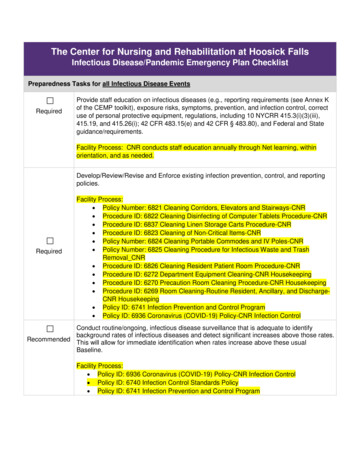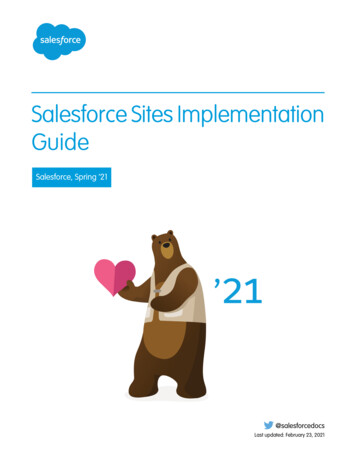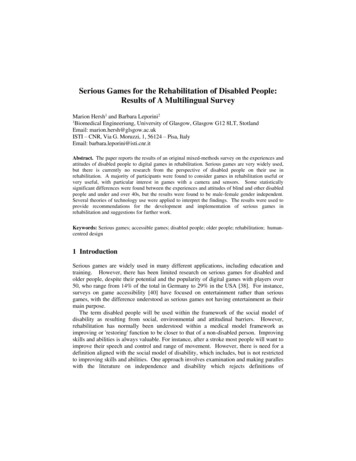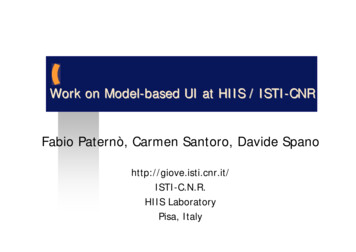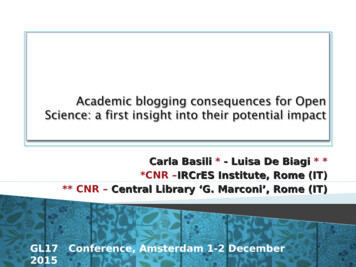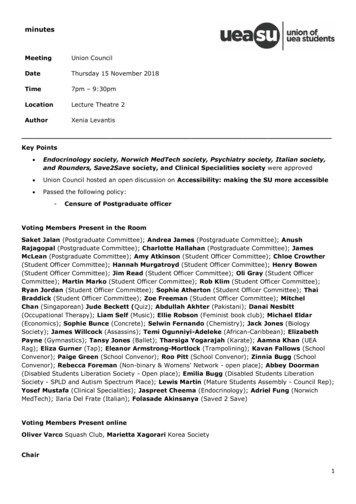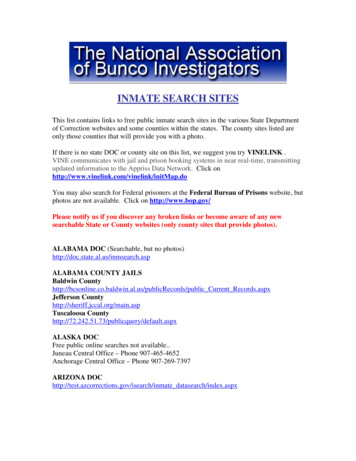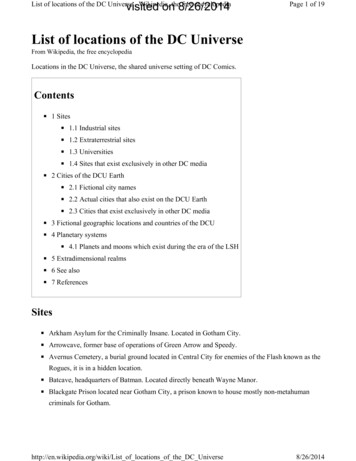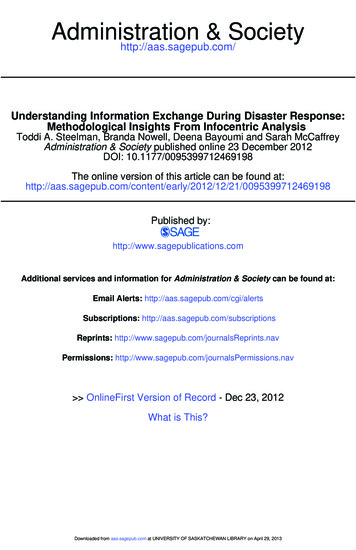
Transcription
Administration& Societyhttp://aas.sagepub.com/Understanding Information Exchange During Disaster Response:Methodological Insights From Infocentric AnalysisToddi A. Steelman, Branda Nowell, Deena Bayoumi and Sarah McCaffreyAdministration & Society published online 23 December 2012DOI: 10.1177/0095399712469198The online version of this article can be found /0095399712469198Published by:http://www.sagepublications.comAdditional services and information for Administration & Society can be found at:Email Alerts: http://aas.sagepub.com/cgi/alertsSubscriptions: http://aas.sagepub.com/subscriptionsReprints: ions: http://www.sagepub.com/journalsPermissions.nav OnlineFirst Version of Record - Dec 23, 2012What is This?Downloaded from aas.sagepub.com at UNIVERSITY OF SASKATCHEWAN LIBRARY on April 29, 2013
46919898Administration & SocietySteelman et al. 2012 SAGE tion & Society OnlineFirst, published on December 23, 2012 tion ExchangeDuring Disaster Response:Methodological InsightsFrom Infocentric AnalysisAdministration & SocietyXX(X) 1 –37 2012 SAGE PublicationsDOI: i A. Steelman1, Branda Nowell2, DeenaBayoumi2, and Sarah McCaffrey3AbstractWe leverage economic theory, network theory, and social network analyticaltechniques to bring greater conceptual and methodological rigor to understandhow information is exchanged during disasters.We ask, “How can informationrelationships be evaluated more systematically during a disaster response?”“Infocentric analysis”—a term and approach we develop here—can (a) definean information market and information needs, (b) identify suppliers of information and mechanisms for information exchange, (c) map the informationexchange network, and (d) diagnose information exchange failures.These stepsare essential for describing how information flows, diagnosing complications,and positing solutions to rectify information problems during a disaster.Keywordsdisasters, information, social network analysis, interorganizationalcoordination communication, exchange markets, infocentric social networkanalysis, wildfire1University of Saskatchewan, Saskatoon, CanadaNorth Carolina State University, Raleigh, USA3US Forest Service Northern Research Station, Chicago, IL, USA2Corresponding Author:Toddi A. Steelman, University of Saskatchewan, 329 Kirk Hall, 117 Science Place, Saskatoon,Saskatchewan, Canada S7N 5C8Email: toddi.steelman@usask.caDownloaded from aas.sagepub.com at UNIVERSITY OF SASKATCHEWAN LIBRARY on April 29, 2013
2Administration & Society XX(X)Understanding Information Markets During aDisaster Response:The Need for an InfocentricApproachDuring a disaster, a fundamental management challenge is communicationand information exchange in what is usually a highly complex and uncertainenvironment (Kapucu, 2006). In these conditions, communication and information needs are diverse, unpredictable, and continuously changing withregard to scope, urgency, and information type (Comfort & Kapucu, 2006).Consequently, effectively coordinating relevant information among andacross stakeholder groups can be a significant challenge. Communicationunder these dynamic and ambiguous conditions has often been studied underthe domain of crisis and emergency communication (Heath, Jaesub, & Lan,2009; Seeger, 2006; Seeger, Sellnow, & Ulmer, 2003; Williams & Olaniran,1998) but with little focus on methodological innovation related to how suchefforts could be structured for better understanding. The research questionwe address in this article is:How can we more systematically evaluate information exchanges during a disaster response?In this article, we describe a methodological approach—“infocentricanalysis”—that can be used to better inform disaster response.Despite the crucial need for understanding how to ensure accurate andtimely information during disaster (Comfort & Kapucu, 2006), many aspectsof disaster management have been under-conceptualized (Herzog, 2007;Magsino, 2009; McEntire, Fuller, Johnston, & Webber, 2002). In particular,the extant literature on disaster communication among responders has beendominated by a technocentric perspective, aimed at diagnosing the causesand consequences of failures in the communication infrastructure (Comfort& Haase, 2006; Dilmaghani & Roao, 2007). Although infrastructure is a keycomponent in understanding the flow of information during a response, technology operates within a much broader social context defined by a networkof responders exchanging an array of information. Crisis communicationscholars often investigate the message and processes associated with thetimely, accurate distribution of information during the event (Seeger, 2006;Seeger et al., 2003). In addition, there is a small but growing literature aimedat investigating interactions among responders using a network-level perspective as a means for understanding information exchange (Choi & Brower,2006; Comfort & Kapucu, 2006; Kapucu, 2005, 2006; Magsino, 2009). ThereDownloaded from aas.sagepub.com at UNIVERSITY OF SASKATCHEWAN LIBRARY on April 29, 2013
Steelman et al.3remains a dearth of theoretical and methodological approaches for capturingthe structure of interactions among responders related to specific domains ofinformation to aid in the diagnoses of communication breakdowns.Toward this end, we argue for the value of an infocentric approach. Theimport of such an approach is rooted in two key theoretical propositions concerning the nature of information and its exchange during a disaster. We startwith the proposition that information is not monolithic. There are multipletypes of information being sought and exchanged during a disaster, and different types of information will lend themselves to different mediums ofexchange all the while facing unique challenges. Second, we posit that information needs are not universal among responders. Responders will have different information needs based on their functional role in the response, thecontext of the incident itself, and a responder’s position in the network.Consequently, if one desires to understand the structure and dynamics ofinformation exchange, a theoretical and methodological approach must bearticulated that is infocentric, capable of representing the unique collection ofresponders and the pattern of exchanges among them associated with a specific domain of information.Drawing from general economic theory, we approach the challenge ofeffective information exchange during a disaster as a problem of informationasymmetry among those who possess information (suppliers) and those whoneed it (consumers). Disasters can be straightforwardly conceptualized interms of a market or network of actors (e.g., residents, leaders, and staff ofvarious organizations and agencies) who both supply and demand informationfrom other actors within the network to be effective in accomplishing theirgoals (e.g., managing the fire, avoiding injury or loss of life, protectingpersonal and community assets, restoring vital services). Under dynamicconditions characterized by complexity and uncertainty, the mechanismsof exchange that link information suppliers with information consumers canbe unclear. More specifically, transaction cost theory provides a valuabletheoretical lens for conceptualizing the dynamic flow of information withinthe network of agencies responding to a disaster. In addition, using socialnetwork analysis (SNA) techniques can provide insight into informationdynamics during a disaster. SNA is a diverse and growing group of methodological techniques that allow researchers to represent relationships,relational structure, and their consequences through various protocols thattake into account representation of individuals, groups, or organizations;boundary definition; sampling; instruments for measurement; and visualization approaches.1 However, SNA techniques are a methodology and not atheory. Consequently, we need to leverage appropriate theory to guideDownloaded from aas.sagepub.com at UNIVERSITY OF SASKATCHEWAN LIBRARY on April 29, 2013
4Administration & Society XX(X)application and interpretation of the approach. This focus on information flowwithin an information market allows us to empirically document informationasymmetries and their consequences, as well as provide insight into how suchasymmetries might be addressed for better disaster management. More specifically, we demonstrate how infocentric analysis can be used to documentthe information markets activated during an incident, the nature and structureof these markets, and adequacy of the information exchange among the subnetwork of responders active within a given information market.This article proceeds in seven sections. First, we lay out theoretical concepts from economics, network theory, and SNA that inform thinking aboutinformation exchange and how these concepts apply in a disaster context.Second, we describe our innovative approach—“infocentric analysis”—thatbrings greater conceptual and methodological rigor to understanding information supply, demand, and exchange failures during a disaster response. Inthe remaining sections, we demonstrate how this approach can be used toimprove understanding of information exchange within the specific contextof a forest wildfire event.Exchange Relationships, NetworkGovernance, and SNAOur infocentric perspective on disaster communications among responders isgrounded in theories related to economic exchange. General economic theory suggests that concepts like information asymmetry, uncertainty, risk, andtransactional costs may be helpful in understanding how information isexchanged (Comfort, Kilkon, & Zagorecki, 2004; Stigler, 1961; Williamson,1991). Information asymmetries arise in situations when one individual ororganization has more knowledge than another. When used in a market context, buyers of products seek information to make good choices, often underimperfect circumstances (Stigler, 1961). When sellers or buyers of goods arenot fully informed about the risks they take, they may behave differentlyfrom the way they would behave if risks were fully understood. This isknown as “moral hazard.” Another class of problems, “adverse selection,”occurs when sellers do not have full information about buyers and so mayprovide suboptimal choices for them to purchase. The basic theory behindinformation asymmetry suggests that more optimal choices will be madeunder conditions of better information exchange, and we would expect theseprinciples to apply to a disaster context (Comfort et al., 2004).Although these theoretical concepts are usually used in a market context tounderstand private firm behavior, we apply them to the quasi-public realm ofDownloaded from aas.sagepub.com at UNIVERSITY OF SASKATCHEWAN LIBRARY on April 29, 2013
Steelman et al.5disaster management. During a disaster, the continuously changing contextaffects the scope, urgency, and type of information needed and makes balancing the supply and demand of information challenging. Individuals involved ina disaster usually have different sets of information, and those who have information (supply) may not connect effectively with those who desire the information (demand). Such highly dynamic and uncertain situations can furtherexacerbate the potential negative consequences of any information asymmetryas poor information exchange can limit effective coordination and lead to problems for all parties during an incident.Although general economic theory is helpful for conceptualizing the natureof exchange relationships, it tells us little about how to manage or governunder these conditions. More specifically, transaction cost theory and networkgovernance perspectives are helpful for understanding the structural formsthat can guide these exchange relationships. Williamson (1991) argues that tominimize information exchange transaction costs, governance structures willemerge to support those relationships that are lowest in associated costs andhighest in relative advantages related to the task at hand. Different governancestructures exist to accommodate the diversity of potential exchange relationships. For instance, hierarchical coordination is a structure used to establishcontrol among those governed by allocating responsibility and specifyingtasks. This structure is seen as most efficient during periods of stability wherethere is time to identify problems and correct mistakes. However, under urgentand dynamic conditions where individuals lack relevant information or theability to meet new demands quickly, hierarchical coordination breaks down(Comfort & Kapucu, 2006). In these situations, Jones, Hesterly, and Borgatti(1997) point to the importance of network governance structures in mediatingtransaction costs in dynamic situations where exchanges need to be coordinated quickly—conditions that typify disaster contexts.A SNA is a particularly appropriate methodological approach for assessing network governance structures as it focuses on distinguishing and describing structural components of a network to explain certain outcomes (Provan& Kenis, 2008). SNA uses individuals (nodes) and the relational links (ties)that comprise the network as a focal unit of analysis.Within the disaster literature, the application of network analytic methodsto examine existing systems of emergency management is a small albeitgrowing area of research (Kapucu, 2005, 2006; Magsino, 2009; Topper &Carley, 1999). In assessing the role of interorganizational networks in disaster circumstances, scholars have examined cross-agency coordination indynamic contexts (Kapucu, 2005), boundary spanners in multiagency coordination (Kapucu & Van Wart, 2006), relative interaction within and betweenDownloaded from aas.sagepub.com at UNIVERSITY OF SASKATCHEWAN LIBRARY on April 29, 2013
6Administration & Society XX(X)stakeholder groups during Katrina (Comfort & Haase, 2006), brokerage roleswithin emergent interorganizational networks (Lind, Tirado, Butts, & PetrescuPrahova, 2008), emergency medical preparedness and response (Tierney,1985), and county-level emergency management and the differences betweenthe communication networks that exist in actual practice versus those proposedin county plans (Choi & Brower, 2006). Other scholars have identified SNA asa rich field and method to be applied to disaster situations but have found existing theory and applications lacking (Magsino, 2009).The infocentric approach we present here advances the literature on therole of networks in disasters by adapting SNA techniques to empirically document and analyze the information market that emerges during disasterresponse. We argue that general economic theory has two principal contributions to make to understanding information exchange markets in disasterresponse. First, it provides the conceptual foundation for thinking aboutactors within a social network, their exchange patterns, and the nature of linkages between them. Second, it structures methodological tools for modelingand interpreting these exchanges. Systematically structured and applied, theuse of SNA methods can provide insights into the information exchange market and assist in diagnosing problems of supply and demand of information.Infocentric AnalysisTo understand potential information asymmetries during a disaster response,infocentric analysis first seeks to identify what types of information are insupply and demand. This stands in contrast to prominent applications of SNAapproaches that simply document or visually depict information sharingrelationships while leaving the content ambiguous. Infocentric analysis thenseeks to map the unique network of suppliers and consumers related to aparticular type of information. The assumption underlying this approach isthat there are multiple types of information in demand within a network, andthe presence or absence of a communication tie between two actors is insufficient evidence to assess the effective flow of a particular type of information between suppliers of information and those who need it. Consistent withcommunication process models, communication in infocentric analysis isviewed as two directional and content specific. Furthermore, effective communication within the information market is evaluated from the perspectiveof the consumer in terms of whether it met their needs, not the supplier.Thus, this approach can describe the essential characteristics related toinformation exchange, including the structure of the information market,types of information demanded, identification of those who supply andDownloaded from aas.sagepub.com at UNIVERSITY OF SASKATCHEWAN LIBRARY on April 29, 2013
Steelman et al.7Figure 1. Infocentric analysis processdemand different types of information, and specific vehicles of informationexchange. Infocentric analysis also can assess the capacities and diagnose theweaknesses of this structure. For example, are certain modes of informationexchange more or less effective for certain types of information? To whatextent are key actors effectively supplying specific information to those whodemand it? Are certain information markets deemed more or less satisfactorythan others? If so, why? Are there information exchange relationships thatwere unexpected that might be leveraged more fully in the future? Are theremissing linkages between those who supply information and those whodemand it within the network? Are there ineffective linkages between thosewho supply information and those who demand it?In this way, infocentric analysis describes the information exchange market and identifies ways to facilitate better information exchange during adisaster response. The analysis process can be organized into five sequentialstages: (a) bounding the focal network, (b) defining the information market,(c) identifying and assessing the vehicles of information transfer, (d) mapping the network structure of the information market, and (e) identifying anddiagnosing information exchange failures, as depicted in Figure 1. In the following sections, we demonstrate the application of each of these stages andthe insights that can be gained using a case study of a 2009 wildland fire.Wildfires, Incident Command Systems (ICSs), andInformation NeedsWildfires are the subject of this study because they are one of the most common natural hazards in the United States (EM-DAT: OFDA/CREDInternational Disaster Database, 2012). Because of their more routine nature,they offer the opportunity to identify and test theory, methods, and practicerelated to disaster contexts.Forestlands in the United States are characterized by a declining state ofecologic health and increased propensity for catastrophic wildfire (Schmidt,Downloaded from aas.sagepub.com at UNIVERSITY OF SASKATCHEWAN LIBRARY on April 29, 2013
8Administration & Society XX(X)Menakis, Hardy, Hann, & Bunnell, 2002). Many factors contribute to the current wildfire problem. Shifts in community and residential patterns during the1990s and early 2000s have meant that more people have moved into thewildland–urban interface (WUI), the area where private homes and otherhuman development meet or intermingle with undeveloped wildland (Beebe& Omi, 1993; Hammer, Stewart, & Radeloff, 2009; Radeloff et al., 2005).Climatic conditions (National Wildfire Coordinating Group [NWCG], 2009),insect and disease outbreaks (Logan, Régnière, & Powell, 2003), prolongeddrought (Kitzberger, Swetnam, & Veblen, 2001), and propagation of exoticand indigenous species (Hale, Frelich, & Reich, 2006) have contributed tochanged forest structure and function. Coupled with increased density oftrees and brush due to fire suppression, forested landscapes are increasinglysusceptible to larger and more frequent wildfire events (Pollet & Omi, 2002).Despite greater attention from the federal agencies charged with wildfiremanagement and firefighting efforts exceeding US 1 billion on a regularbasis throughout the 2000s, the risk to life and property has not subsided(NWCG, 2009).A large wildfire event typically is managed through the Incident CommandSystem (ICS). ICS was developed in the 1970s out of a need to centralizeauthority among multiple organizations during wildfire incidents (Irwin,1989). While ostensibly a strict hierarchical structure, the ICS may also benetworked with the local community and other organizations to coordinateresponse. Participants within the wildfire incident can be broadly partitionedinto four stakeholder groupings. The first group includes the core units of theIncident Management Team (IMT), who typically assumes command in managing a large-scale wildfire and largely controls the dissemination of information during the incident. The second group is the local fire response agencythat requests the IMT and plays a role in coordinating disaster response. Thethird group consists of local cooperators that represent of a variety of localorganizations and agencies that have specialized roles related to disaster preparedness and response. The final group comprises individuals affected by thedisaster who are participating in a loose “emergent system” (Drabek &McEntire, 2002, 2003). This group may comprise private citizens who worktogether but are not part of an institutionalized or structured response (Stallings& Quarantelli, 1985). They may have varying degrees of organization andwork independently or in groups.MethodWe pilot tested our infocentric social network approach during a 2009 wildfire. Information needs emerge rapidly and change quickly during a wildfire.Downloaded from aas.sagepub.com at UNIVERSITY OF SASKATCHEWAN LIBRARY on April 29, 2013
Steelman et al.9Consequently, site visits needed to occur during or immediately after anevent. Labeled “quick response research” by Taylor et al. (2007), this type ofresearch requires extensive planning and rapid implementation to ensure thatinformation channels and information exchange between stakeholders areaccurately captured. Case selection criteria for this study were focused onwildfire events located near communities in close proximity to US ForestService (USFS) lands that were administered by a federal IMT (IMT2). Thecommunities surrounding the Dry Creek Fire Complex2 met these criteria.Site visits by the research team began 9 days after the initial fires began andcontinued for 10 days with additional phone interviews conducted within23 days of initial fire ignition.During this fire, we implemented and refined the methodological protocoldocumented here. Prior to fire season, we developed an interview protocolcontaining both closed and open-ended questions that were subsequentlyadministered to individuals who held a leadership role in the management ofthe fire. Interviewees fell into one of four categories: the IMT2, local nationalforest, local cooperators, and key community information brokers. Questionswere targeted to allow for (a) identification of the network, (b) definition ofindividual information markets, (c) identification of the vehicles for information exchange, and (d) identification of information exchange failures. Ourresearch team consisted of four individuals. Teams of two conducted the interviews. One person asked questions while the other person tracked the protocolto ensure all questions were addressed. All interviews were digitally recorded,transcribed, and returned to each interviewee for validation. Data were analyzed using a combination of social network analytic and statistical analysissoftware including UCInet (Borgatti, Everett, & Freeman, 2002) and SPSS.Case Example:The Dry Creek Fire ComplexThe Dry Creek Fire Complex started as a result of a widespread lightningstorm that ignited numerous fires within the region including three largefires burning within the Dry Creek Ranger District as well as an additional34 smaller fires. Due to persistent dry conditions and wind patterns in thelocal national forest, fire size increased dramatically from 100 acres toapproximately 1,000 acres within several hours. At the same time, anothercomplex of fires on private and state land adjacent to the Dry Creek area wasbeing fought by State IMT (referred to hereafter as IMT1).3 As a result of thenumber of fires and subsequent increase in fire activity on federal lands, amore experienced IMT2 assumed command of the Dry Creek Fire Complexon Day 3. By the time the three main fires were contained 12 days followingDownloaded from aas.sagepub.com at UNIVERSITY OF SASKATCHEWAN LIBRARY on April 29, 2013
10Administration & Society XX(X)ignition, more than 10,000 acres had been burned, costing an estimatedUS 7.7 million in suppression expenses.The Dry Creek Fire Complex was confined to a single county and locatedwithin one USFS Ranger District. The forest is characterized by a fragmentedland ownership pattern—USFS land and state-owned parcels are intermingled with private property and rural neighborhoods. This jurisdictional patchwork of management responsibility is not uncommon in Western forestcommunities and contributes to the complexity of fire management.The area covered in the Dry Creek Fire Complex included three communities that were largely rural. Two of the communities were significantlythreatened by the fires. Residents of both communities, as well as nearbyForest Service facilities and private campgrounds, were evacuated. Powerand telephone services were disrupted during the period of extreme firebehavior. In addition, the two major highways that served as primary thoroughfares were closed due to safety concerns. The proximity to the fire andsubsequent evacuation of residents, compounded by an inability to communicate or receive outside information, created significant disruptions in residents’ daily lives and in the operations of several businesses within the twomost affected communities.Applying Infocentric Analysis to theDry Creek Fire Complex Case StudyIn the following section, we describe the five stages of infocentric analysis,as indicated in Figure 1. For each stage, we demonstrate its application indocumenting and assessing the information markets of the Dry Creek FireComplex.Bounding the Focal NetworkThe first challenge in utilizing any social network-based methodology isboundary specification. Boundary specification requires delimiting whichactors will be considered “in” the network and which ones subsequently willbe excluded from consideration. These decisions are high consequence asdifferent boundaries may reveal very different network properties (Laumann,Marsden, & Prensky, 1989). Consequently, the significance of any givennetwork property cannot be understood absent of understanding the boundary decision within which this property was observed.While it has received limited scholarly attention, boundary specification ofa network within a disaster context is particularly significant as boundaries areDownloaded from aas.sagepub.com at UNIVERSITY OF SASKATCHEWAN LIBRARY on April 29, 2013
Steelman et al.11not self-evident. The emergent nature of disaster response makes networkboundaries both ambiguous and dynamic (Drabek & McEntire, 2002, 2003).This requires the researcher to create and articulate decision rules for determining network membership and to consider the ramifications of these boundarydecisions when interpreting network analysis results. Laumann et al. (1989)describe two approaches to boundary specification in network studies. Therealist approach utilizes group boundaries that are defined and set by the network actors themselves. For example, members of a baseball team define andset their own boundaries as to who is and is not part of the team. The nominalistapproach defines network membership based on theoretical concerns of theresearcher. For example, the researcher may be interested in studying a networkof organizations that are active in responding to a given disaster.In general, we find that understanding information exchange in disastersbenefits from a hybrid approach. The realist approach is partially appropriatedue to the predefined roles of some participants in a disaster network. Inwildfire response, the ICS structure defines a formal network of respondersto a wildfire event. These are key individuals who have specific leadershipresponsibilities during a fire. Furthermore, disaster planning and preparedness efforts in some communities may have established a disaster responsenetwork (e.g., Choi & Brower, 2006). These efforts create a formal networkof organizations, agencies, and individuals who have recognized capabilitiesand responsibilities during a disaster.However, a purely realist approach has several limitations when applied toa disaster response context. First, communities may vary greatly in the extentand inclusiveness of their disaster planning efforts, both of which will affect theface validity of the realist network in representing the actual disaster response.Second, because the response to a large-scale disaster, such as a wildfire event,is complex and difficult to fully anticipate in advance, the actual network ofresponders is often emergent (Choi & Brower, 2006; Drabek & McEntire,2002, 2003). Furthermore, research by Choi & Brower (2006) shows thatactual network structure can become decoupled from the formally prescribednetwork structure outlined in disaster management plans, particularly whenissues of organizational capacity arise. Last, while it is likely that all respondersare known by some part of the network, increases in scale, specialization, andfunctional divisions that occur in managing large-scale disasters make it difficult for any one member to fully grasp the scope of the entire network(Moynihan, 2009). As such, a nominalist strategy that d
Administration & Society OnlineFirst, published on December 23, 2012 as Downloaded from aas.sagepub.com at UNIVERSITY OF SASKATCHEWAN LIBRARY on April 29, 2013. . we apply them to the quasi-public realm of Downloaded from aas.sagepub.com at UNIVERSITY OF SASKATCHEWAN LIBRARY on April 29, 2013. Steelman et al. 5
